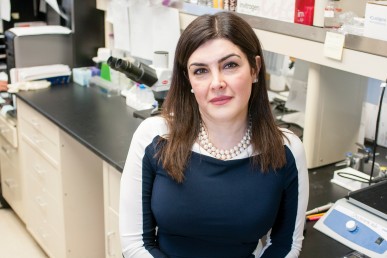Two proteins play key role in rheumatoid arthritis
Two protein molecules that fit together as lock and key seem to promote the abnormal formation of blood vessels in joints affected by rheumatoid arthritis, according to researchers at the University of Illinois at Chicago College of Medicine, who found that the substances are present at higher levels in the joints of patients affected by the disease.

Shiva Shahrara, associate professor of rheumatology. Photo: Joshua Clark ( Click on image for larger file size)
Their results are reported in the journal Annals of the Rheumatic Diseases.
“Our results show, for the first time, that these two proteins – a receptor and its corresponding binding protein – play a key role in the progression of rheumatoid arthritis pathology,” said Shiva Shahrara, associate professor of rheumatology at UIC.
Rheumatoid arthritis is a chronic autoimmune inflammatory disease in which the body’s own defenses attack the tissues lining the joints, causing painful swelling and bone erosion that can ultimately lead to joint deformities.
One of the hallmarks of rheumatoid arthritis is the development of new blood vessels, or angiogenesis, in the joints.
“The swelling of joints is caused by the abnormal migration of a variety of different cell types into the joint,” Shahrara said. “And as these cells accumulate, they need to be supplied with oxygen and nutrients, and so angiogenesis accompanies the joint swelling.”
Shahrara and her colleagues knew that a protein called CCL28 was found in the body under low oxygen conditions, or hypoxia. Joints affected by rheumatoid arthritis can become hypoxic, so the researchers wanted to see if the protein and its receptor could be found in patients’ affected joints.
The researchers measured the levels of the proteins in the tissues and fluid of joints from patients with rheumatoid arthritis and with osteoarthritis, the more common joint inflammation caused by physical wear and tear. Patients of both types had protein levels in their joints that were significantly higher than individuals without joint disease.
The investigators found that CCL28, which is over-produced in joints affected by rheumatoid arthritis, attracts the surface-lining cells that carry its receptor.
When the researchers added CCL28 to cells carrying the receptor, the cells organized into blood vessels. But if they chemically blocked the receptor and added CCL28, formation of blood vessels was reduced.
The finding, Shahrara said, provides “strong evidence” that the binding of CCL28 to joint-lining cells carrying its corresponding receptor is a necessary step in angiogenesis.
Zhenlong Chen and Seung-jae Kim of the UIC department of medicine, UIC student Abdul Essani, and Michael Volin of Midwestern University performed the research and are coauthors on the paper. Dr. Nadera Sweiss, Latrise Sardin, Dr. Suncica Volkov, Dr. Shiva Arami, Dr. William Swedler and Dr. Olga Vila, UIC department of medicine, are coauthors on the paper.
This research was funded by National Institutes of Health grant AR055240, U.S. Department of Defense grant PR093477, and grants from the American College of Rheumatology and the Arthritis Foundation.
Categories
Topics
arthritis, disability, health care, immune system, joint disease, rheumatoid arthritis
